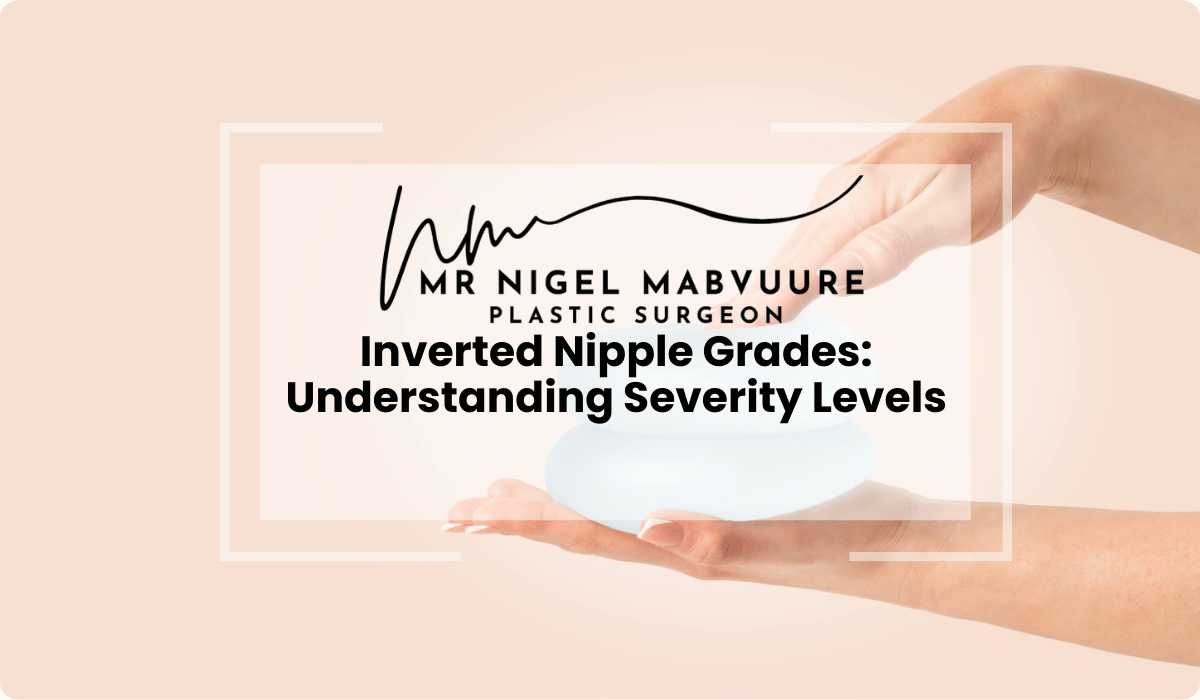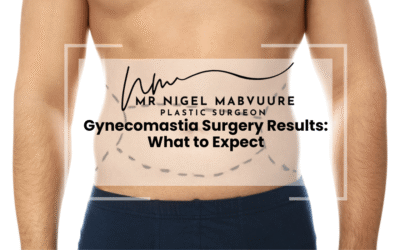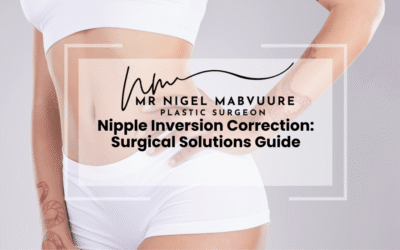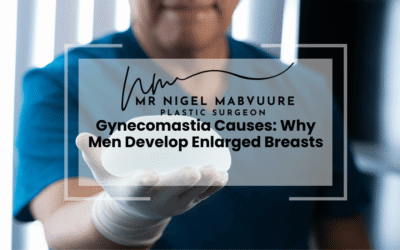Essential Insights on Inverted Nipple Grades
- Inverted nipples are classified into three grades based on severity: Grade 1 (mild, easily everted), Grade 2 (moderate, temporarily everted), and Grade 3 (severe, cannot be manually everted).
- Self-assessment at home can provide preliminary understanding of your inversion grade through visual examination, manual manipulation tests, and sustainability observations.
- Non-surgical treatments like the Hoffman Technique and suction devices are most effective for Grade 1 and some Grade 2 cases, while Grade 3 typically requires surgical intervention.
- Breastfeeding capability decreases with increasing inversion severity—most Grade 1 cases can breastfeed successfully, Grade 2 may require assistance, and untreated Grade 3 typically prevents breastfeeding.
- Surgical correction options range from minimally invasive, duct-preserving techniques for Grade 1 to complete duct division procedures for Grade 3, with corresponding impacts on future breastfeeding ability.
Table of Contents
- What Are Inverted Nipple Grades and Classification Systems?
- Grade 1 Inverted Nipples: Symptoms and Characteristics
- Grade 2 Inverted Nipples: Moderate Inversion Explained
- Grade 3 Inverted Nipples: Severe Inversion Challenges
- How to Determine Your Inverted Nipple Grade at Home
- Non-Surgical Treatments for Different Nipple Inversion Levels
- Surgical Correction Options Based on Nipple Inversion Severity
- Breastfeeding and Sensation: Impact Across Inversion Grades
What Are Inverted Nipple Grades and Classification Systems?
Inverted nipples occur when the nipple points inward or retracts into the breast tissue rather than protruding outward. This condition affects approximately 10-20% of women and can occur in one or both breasts. Understanding the severity of nipple inversion is crucial for determining appropriate treatment options, which is why medical professionals use grading systems to classify the condition.
The most widely accepted classification system divides inverted nipples into three distinct grades based on severity, nipple retraction level, and functional impact. This three-tier system was developed by Schwager and colleagues and has become the standard for assessing nipple inversion in clinical practice.
The grading system evaluates several key factors:
- Degree of nipple retraction
- Ease of manual nipple eversion
- Duration of eversion after manual manipulation
- Presence and condition of milk ducts
- Impact on breastfeeding capability
Nipple inversion can be congenital (present from birth) or acquired later in life due to various factors including breast surgery, trauma, infection, or conditions like mammary duct ectasia. The classification system applies to both types, though treatment approaches may differ based on the underlying cause.
Grade 1 Inverted Nipples: Symptoms and Characteristics
Grade 1 represents the mildest form of nipple inversion and is characterised by nipples that are easily drawn out with gentle manual manipulation. These nipples maintain their projection for extended periods after being everted and may even spontaneously protrude in response to cold temperatures or stimulation.
Key characteristics of Grade 1 inverted nipples include:
- Minimal fibrosis (scarring) of the milk ducts
- Soft tissue that responds readily to manipulation
- Ability to maintain eversion without immediate retraction
- Normal sensation in most cases
- Minimal to no interference with breastfeeding capability
Individuals with Grade 1 inversion often experience what is sometimes called “shy nipples” – nipples that may appear inverted at rest but can protrude normally with stimulation or temperature changes. The milk ducts remain intact and functional, allowing for normal lactation in most cases.
This mild form of inversion typically doesn’t require medical intervention unless it causes psychological distress or aesthetic concerns. Many individuals with Grade 1 inversion successfully breastfeed without complications, as the baby’s suckling action is usually sufficient to draw out the nipple during feeding. Non-surgical interventions like nipple eversion techniques are often effective for this grade of inversion.
Grade 2 Inverted Nipples: Moderate Inversion Explained
Grade 2 inverted nipples represent a moderate level of inversion with more significant structural challenges than Grade 1. These nipples can still be manually everted with moderate pressure or suction devices, but they quickly retract back into the breast tissue once the manipulation stops.
The defining characteristics of Grade 2 inverted nipples include:
- Moderate fibrosis of the underlying connective tissue
- Shortened milk ducts that create tension when the nipple is pulled outward
- Temporary eversion that doesn’t sustain itself
- Partial retraction that may worsen during hormonal fluctuations
- Variable impact on breastfeeding capability
Individuals with Grade 2 inversion often notice that their nipples can be drawn out temporarily but require consistent stimulation or devices to maintain projection. The underlying cause involves moderately shortened milk ducts and fibrous bands that pull the nipple inward. These structural limitations create a more persistent inversion than Grade 1 cases.
Breastfeeding may be challenging but is often still possible with Grade 2 inversion, though mothers might require additional support such as breast shields or lactation consultant guidance. Some individuals may experience mild discomfort or sensitivity in the nipple area due to the tension in the ducts when attempting eversion.
Treatment options for Grade 2 inversion range from non-surgical approaches like suction devices to surgical interventions that release the restrictive fibrous bands while potentially preserving milk duct function.
Grade 3 Inverted Nipples: Severe Inversion Challenges
Grade 3 represents the most severe form of nipple inversion, characterised by significant retraction that cannot be manually corrected with simple manipulation. These nipples remain firmly inverted despite attempts at eversion through pressure or suction, indicating substantial structural restrictions within the breast tissue.
The hallmark features of Grade 3 inverted nipples include:
- Severe fibrosis and scarring of the underlying tissue
- Significantly shortened milk ducts creating strong retraction
- Complete inability to evert the nipple manually
- Deep inversion that may create a visible dimple or depression
- Major impediment to breastfeeding in most cases
The structural limitations in Grade 3 inversion involve dense fibrous tissue and severely shortened milk ducts that firmly anchor the nipple to deeper breast structures. This creates a strong inward pull that resists even forceful attempts at eversion. The condition is typically present from birth (congenital) but can occasionally develop after trauma, infection, or certain breast surgeries.
Individuals with Grade 3 inversion often experience hygiene challenges as the inverted area can trap moisture and skin debris, potentially leading to irritation or infection. The deep inversion may also create aesthetic concerns and psychological distress for some patients.
Breastfeeding is typically not possible with untreated Grade 3 inversion due to the baby’s inability to latch onto the deeply retracted nipple. Surgical intervention is usually the only effective treatment option for this grade, often requiring the division of milk ducts to achieve correction.
How to Determine Your Inverted Nipple Grade at Home
While a definitive diagnosis should always come from a medical professional, there are several self-assessment techniques you can use to preliminarily determine your nipple inversion grade at home. This information can be valuable when consulting with healthcare providers about potential treatment options.
To perform a basic self-assessment:
- Visual examination: Stand in front of a mirror in good lighting and observe your nipples in their natural state. Note whether they protrude outward, lie flat, or retract inward.
- Manual manipulation test: Place your thumb and index finger on the areola (the pigmented area surrounding the nipple) about 1-2 cm from the base of the nipple. Gently compress the tissue and observe whether the nipple everts (points outward).
- Sustainability test: If your nipple does evert with compression, note how long it maintains this position after you release the pressure. Grade 1 nipples will stay everted for an extended period, while Grade 2 will quickly retract.
- Resistance assessment: Note how much pressure is required to achieve eversion. Grade 1 requires minimal pressure, Grade 2 needs moderate pressure, and Grade 3 cannot be everted despite significant pressure.
Based on these observations, you can make a preliminary assessment:
- Likely Grade 1: Nipple everts easily with gentle pressure and maintains projection for some time after release.
- Likely Grade 2: Nipple can be everted with moderate pressure but quickly retracts when pressure is released.
- Likely Grade 3: Nipple remains inverted despite significant pressure; no amount of manipulation achieves eversion.
Remember that factors like temperature, hormonal fluctuations, and recent stimulation can affect nipple projection temporarily. For the most accurate assessment, perform this self-examination multiple times under similar conditions.
Non-Surgical Treatments for Different Nipple Inversion Levels
Non-surgical approaches to nipple inversion vary in effectiveness depending on the grade of inversion. These conservative methods are typically most successful for Grade 1 and some Grade 2 cases, offering less invasive alternatives to surgical correction.
For Grade 1 Inverted Nipples:
- Hoffman Technique: This manual exercise involves placing thumbs or fingers on opposite sides of the nipple base and gently pulling outward and away from each other. Performed regularly, this can gradually stretch the restrictive tissue.
- Suction Devices: Products like the Niplette™ create gentle, sustained suction that gradually draws the nipple outward. When used consistently over several months, these devices can create lasting improvement for Grade 1 inversion.
- Breast Shells: Worn inside the bra, these dome-shaped devices apply constant gentle pressure to help evert the nipple over time.
For Grade 2 Inverted Nipples:
- Sustained Suction Therapy: More intensive and consistent use of suction devices may help some Grade 2 cases, though results are less predictable than with Grade 1.
- Nipple Stimulation Techniques: Regular stimulation combined with manual eversion can sometimes yield improvement in moderate cases.
- Piercings: Some individuals find that nipple piercings can mechanically prevent retraction, though this approach carries risks of infection and is not medically recommended.
For Grade 3 Inverted Nipples:
Non-surgical treatments are rarely effective for Grade 3 inversion. The severe fibrosis and structural limitations typically require surgical intervention for meaningful correction. However, some patients may attempt conservative methods before considering surgery.
It’s important to note that non-surgical approaches require consistency and patience, with results developing gradually over weeks or months rather than immediately. For individuals concerned about breastfeeding, consultation with a lactation specialist is recommended, as some non-surgical techniques can be specifically tailored to prepare for breastfeeding.
Surgical Correction Options Based on Nipple Inversion Severity
Surgical correction of inverted nipples offers a permanent solution for all grades of inversion, with techniques varying based on the severity of the condition and whether preservation of milk ducts is desired. These procedures are typically performed under local anaesthesia as outpatient treatments.
For Grade 1 Inverted Nipples:
- Minimally Invasive Techniques: Small incisions at the base of the nipple allow for the release of fibrous bands while preserving milk ducts.
- Purse-String Suture Method: This technique uses special stitches to maintain nipple projection after the restrictive tissue is released.
- Recovery: Typically quick, with minimal discomfort and high success rates. Most patients can return to normal activities within 1-2 days.
For Grade 2 Inverted Nipples:
- Duct-Preserving Techniques: When possible, surgeons may use methods that carefully release fibrous tissue while attempting to maintain the integrity of major milk ducts.
- Limited Duct Division: Some cases require selective division of certain ducts to achieve projection while preserving others for potential breastfeeding.
- Recovery: Slightly longer than Grade 1, with patients typically resuming normal activities within 3-5 days. Temporary sensitivity is common.
For Grade 3 Inverted Nipples:
- Complete Duct Division: The severe retraction in Grade 3 cases typically necessitates complete division of milk ducts to achieve lasting correction.
- Tissue Rearrangement: Additional techniques may include internal suturing and tissue rearrangement to create structural support for the newly everted nipple.
- Recovery: More extensive, with full healing taking 1-2 weeks. Patients should avoid strenuous activities and follow specific aftercare instructions.
All surgical approaches aim to create natural-looking, permanently everted nipples. Success rates are high across all grades, though patients should understand that Grade 3 corrections typically sacrifice breastfeeding ability in exchange for aesthetic improvement and resolution of functional issues like hygiene concerns.
Post-operative care typically includes wearing protective shields to prevent pressure on the newly everted nipples and following specific wound care instructions to optimise healing and minimise scarring.
Breastfeeding and Sensation: Impact Across Inversion Grades
The relationship between nipple inversion, corrective treatments, and their impact on both breastfeeding capability and nipple sensation varies significantly across the different grades of inversion. Understanding these implications is crucial for individuals making decisions about treatment options.
Breastfeeding Considerations:
- Grade 1 Inversion: Most women with Grade 1 inversion can breastfeed successfully without intervention. The baby’s suckling action is often sufficient to draw out the nipple. Non-surgical treatments like the Hoffman Technique or suction devices used during pregnancy can further improve outcomes.
- Grade 2 Inversion: Breastfeeding may be challenging but is often possible with proper support. Lactation consultants may recommend breast shields.
Frequently Asked Questions
Can inverted nipples correct themselves naturally over time?
Inverted nipples rarely correct themselves completely without intervention, especially in Grade 2 and 3 cases. However, Grade 1 inverted nipples may occasionally become more projecting during hormonal changes like puberty, pregnancy, or breastfeeding. These changes are typically temporary for moderate to severe inversion, with the nipples returning to their inverted state afterward. Consistent use of non-surgical techniques like the Hoffman method or suction devices offers the best chance for natural improvement in mild cases.
How does pregnancy affect inverted nipples?
Pregnancy often temporarily improves nipple inversion due to hormonal changes that increase breast tissue elasticity and nipple sensitivity. Many women with Grade 1 inversion find their nipples become more projecting during pregnancy. Grade 2 inversion may show some improvement, while Grade 3 typically remains unchanged. These pregnancy-related changes are usually temporary, particularly for moderate to severe inversion. The third trimester is an ideal time to begin non-surgical treatments like the Hoffman Technique to prepare for breastfeeding.
Will correcting inverted nipples affect nipple sensitivity?
The impact on nipple sensitivity depends on the correction method used. Non-surgical approaches typically don’t affect sensation. Surgical correction for Grade 1 and some Grade 2 cases using duct-preserving techniques generally maintains most sensation, with temporary numbness or hypersensitivity during healing. More invasive surgeries for Grade 3 inversion that require complete duct division have a higher risk of permanent sensation changes. Most patients report that any reduction in sensitivity is minor compared to the benefits of correction.
Are there any risks associated with leaving inverted nipples untreated?
Untreated inverted nipples pose few medical risks for most individuals. The main concerns include potential hygiene issues, as the inverted area can trap moisture and debris, occasionally leading to irritation or infection, particularly in Grade 3 cases. Breastfeeding difficulties represent another functional concern, especially with moderate to severe inversion. Many people seek treatment primarily for aesthetic reasons or psychological comfort rather than medical necessity. Regular cleaning and monitoring for any unusual changes remain important for those who choose not to pursue correction.
How successful are surgical corrections for inverted nipples?
Surgical correction success rates are generally high across all inversion grades, with 85-95% of patients achieving permanent improvement. Grade 1 and 2 corrections have the highest success rates (90-95%), while Grade 3 cases still achieve good results (85-90%) but may require more extensive techniques. Recurrence rates are approximately 5-10%, with most occurring within the first year after surgery. Factors affecting success include the surgical technique used, the surgeon’s experience, proper post-operative care, and the patient’s natural healing response.
Can men have inverted nipples, and are treatments different?
Yes, men can have inverted nipples, with the condition affecting approximately 2-3% of males. The same grading system applies to men, and the underlying anatomical causes are similar. Treatment options are largely the same, though the surgical approach may be simpler in men due to the absence of milk ducts. Since breastfeeding preservation isn’t a concern, surgeons typically use techniques that prioritize aesthetic outcomes and minimal scarring. Men seek correction primarily for aesthetic reasons or to address hygiene concerns associated with deeper inversions.
How long do results from non-surgical treatments for inverted nipples last?
Results from non-surgical treatments vary significantly based on inversion grade and consistency of application. For Grade 1 inversion, diligent use of suction devices or the Hoffman Technique for 3-6 months can produce lasting results in approximately 30-50% of cases. Grade 2 inversion responds less predictably, with temporary improvement during treatment but frequent reversion when techniques are discontinued. Grade 3 inversion rarely responds to non-surgical approaches. Maintenance sessions are often necessary to sustain results, particularly for moderate inversion. Pregnancy and breastfeeding may either improve or worsen results depending on individual tissue characteristics.




